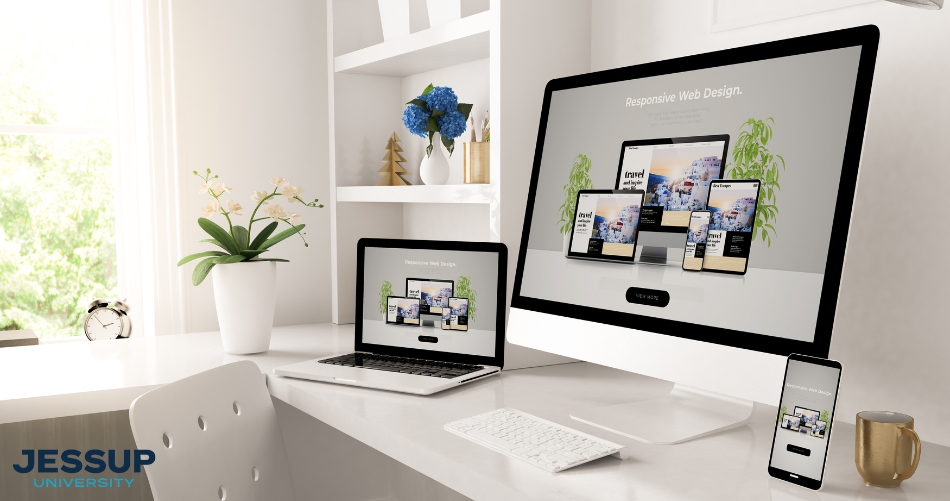Finding the Uses of Website Design for Enhancing Individual Experience
Website design considerably influences customer experience throughout electronic systems. By concentrating on individual requirements, designers develop internet sites that are not just aesthetically attractive but easily accessible and likewise practical. Key elements such as receptive style and user-friendly navigating play essential roles in boosting functionality. The difficulty exists in comprehending how these parts communicate to fulfill progressing user assumptions. The expedition of these factors exposes understandings that could transform electronic engagement.
Recognizing Individual Needs and Expectations
Just how can Web developers properly align their productions with individual demands and assumptions? To accomplish this, designers must participate in comprehensive individual study to record the choices, habits, and pain points of their target market. Utilizing approaches such as studies, meetings, and use screening, designers collect valuable insights that guide their decision-making process.
Developing individual characters can further help in imagining different user sections, making certain that style options resonate with actual users. Furthermore, designers need to focus on instinctive navigation and clear phone call to action, which help with seamless communications.
The Importance of Responsive Style
As customers significantly access websites on a variety of tools, receptive style has actually become crucial for developing a positive individual experience. This strategy enables Web pages to adapt seamlessly to different screen sizes, ensuring that material is conveniently readable and accessible, no matter whether an individual gets on a tablet computer, desktop, or mobile phone .
Responsive layout enhances functionality by giving a constant experience, lowering the need for too much scrolling or zooming. Additionally, internet search engine prefer receptive sites, which can improve a site's presence and reach. This design strategy also streamlines advancement efforts, as it eliminates the need for several versions of a site customized to specific devices.
Incorporating receptive layout not just fulfills individual assumptions but additionally straightens with contemporary Web criteria, cultivating involvement and satisfaction. Eventually, it symbolizes a commitment to ease of access and inclusivity, crucial elements for any kind of successful on the internet visibility.
Creating Instinctive Navigation
An effective website design not only includes responsive formats but likewise prioritizes user-friendly navigation, which is essential for leading customers via a site perfectly. Instinctive navigation guarantees that customers can easily situate info without unnecessary initiative. Key components consist of a clear food selection structure, rational categorization of web content, and recognizable icons or tags.
Uniformity in navigating placement across various pages fosters familiarity, enhancing customer convenience. Using breadcrumb routes allows individuals to track their location within the website, aiding in backtracking and exploration. In enhancement, enhancing navigating for smart phones is essential, as numerous customers access web sites through smartphones and tablets.
Integrating a search bar can in addition simplify the user experience, enabling fast access to particular material. On the whole, user-friendly navigation decreases frustration, encourages longer website check outs, and eventually causes greater user contentment and involvement. By focusing on navigation style, Web designers can greatly improve the overall individual experience.
Using Aesthetic Hierarchy Properly
Reliable Web style rests on the strategic usage of aesthetic pecking order, making certain that customers can effortlessly browse web content and realize one of the most crucial info at a glimpse. By prioritizing components based on their value, developers can direct customers' focus towards essential locations, such as headings, calls-to-action, and necessary images.
Strategies such as dimension, placement, contrast, and shade play critical roles in developing this pecking order. Larger message commonly symbolizes better significance, while contrasting shades can draw focus to essential activities. Additionally, regular alignment and spacing aid create an arranged layout, making it much easier for customers to process details rapidly.
In addition, including imagery tactically can boost understanding and retention of material. When made use of successfully, a distinct aesthetic hierarchy not just boosts usability but likewise improves the total customer experience, allowing customers to involve meaningfully with the website's objectives.
Enhancing Readability and Ease Of Access
Aesthetic pecking order considerably affects just how users interact with a website, but equally important is guaranteeing that material stays accessible and understandable to all audiences. Effective Web style employs clear typography, consisting of proper font dimensions, line spacing, and comparison to enhance readability. Using high-contrast color pattern can aid those with visual disabilities, while larger message dimensions benefit individuals with checking out problems. Additionally, incorporating alt text for images assurances that individuals making use of screen readers can access important information.
Developers should additionally think about the design and structure of content, making use of headings and bullet factors to break up large blocks of text. This not just aids skimming but also helps customers with cognitive disabilities. Ultimately, focusing on readability and access promotes a comprehensive setting, permitting varied target markets to involve totally with the site's web content (website development). By dealing with these elements, Web developers can significantly improve the overall individual experience
Including Involving Visual Components
Incorporating appealing visual components is necessary for boosting individual experience in Web style. Shade psychology plays a considerable function in affecting users' feelings and behaviors, while interactive graphics can capture attention and encourage expedition. With each other, these components develop a more attractive and vibrant on the internet setting.
Relevance of Color Psychology
The value of shade psychology in website design can not be overemphasized, as it plays an essential duty fit customer assumptions and habits. Shades stimulate feelings and can affect how individuals communicate with a site. Blue frequently conveys depend on and professionalism and trust, making it a prominent choice for economic establishments. Conversely, red can set off urgency and exhilaration, frequently used in sales promotions. Understanding the psychological effects of shade enables developers to create a cohesive aesthetic experience that resonates with users. Furthermore, consistent color design enhance brand name identity and acknowledgment, making sure users associate certain colors with certain brand names. Ultimately, thoughtful application of color psychology can considerably boost customer involvement and fulfillment, making it a fundamental aspect of efficient website design.
Using Interactive Graphics
Involving users via interactive graphics can considerably improve their total experience on a web site. These elements, such as computer animations, infographics, and clickable visuals, promote a much deeper connection between users and the web content. By urging exploration and participation, interactive graphics can make intricate info a lot more like this digestible and preserve customers' attention longer. Furthermore, they supply a chance for users to communicate with the website in a meaningful method, causing raised satisfaction and a higher possibility of returning. Nonetheless, it is crucial to stabilize interactivity with usability; excessively complicated graphics might perplex individuals. Correctly carried out, interactive graphics can transform an easy watching experience into an interesting trip, ultimately adding to enhanced user experience and site performance.
Continuous Checking and Enhancement Strategies
Continual testing and enhancement approaches serve as crucial elements in optimizing Web design for individual experience. By applying repetitive testing, developers can collect real-time feedback on individual communications, permitting them to determine discomfort factors and areas for improvement - web development. A/B screening, use screening, and warm mapping are reliable methods that offer insights right into individual actions, making it possible for educated style choices
These strategies urge a society of continuous refinement, rather than an one-time launch. Web developers can make use of analytics tools to monitor efficiency metrics, such as bounce rates and conversion rates, which direct required adjustments. Regular updates based on individual responses not just boost performance however likewise foster user satisfaction and commitment.
Ultimately, continual screening and improvement produce a responsive website design setting where individual experience is prioritized, guaranteeing that the website progresses alongside customer needs and technical improvements. This aggressive approach leads to an extra interesting and effective online presence.
Regularly Asked Inquiries
How Can Color Psychology Impact Customer Experience in Website Design?
Color psychology substantially influences customer experience in Web design by evoking emotions and guiding habits. Different shades can develop associations, boost readability, and impact customer interaction, eventually forming understandings of a brand name or web site's capability.
What Role Does Typography Play in Individual Interaction?
Typography considerably influences customer interaction by boosting readability, establishing hierarchy, and sharing brand name individuality. Effective font options can capture interest, stimulate emotions, and overview users through material, eventually enhancing general interaction and contentment with the website.

Just How Do Social Differences Influence Web Style Preferences?
Cultural differences greatly affect website design preferences, affecting color choices, images, design, and navigating designs. Recognizing these variations permits developers visit site to develop more engaging and relatable experiences customized to varied individual histories and assumptions.

What Tools Can Assist Examination Customer Experience Successfully?
Different devices, consisting of Google Analytics, Hotjar, and UsabilityHub, effectively test individual experience. These platforms supply understandings into customer actions, facilitate A/B testing, and gather comments, assisting developers make notified decisions to improve total usability.
Exactly how Commonly Should a Website Be Redesigned for Optimal Individual Experience?
A website ought to be redesigned every a couple of years to preserve ideal user experience. Normal updates ensure the style remains contemporary, responsive, and lined up with advancing customer requirements and technological developments, boosting total involvement.
Creating individual personalities can even more assist in envisioning various customer sections, making certain that layout choices resonate with real users. As users increasingly gain access to web sites on a range of devices, receptive layout has actually come to be important for creating a positive customer experience. Integrating engaging aesthetic components is important for enhancing customer experience in Web design. Inevitably, constant testing and renovation produce a responsive Web layout atmosphere where user experience is prioritized, ensuring that the website Learn More develops along with individual demands and technological developments. Shade psychology considerably influences user experience in Web style by directing and evoking feelings behavior.